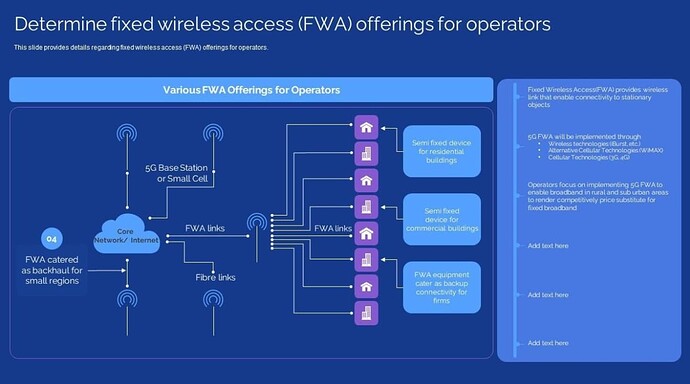Phase 1: 3.5 GHz + Indoor/Outdoor CPE Deployment
-
Network Planning:
- Conduct synchronous planning to ensure FWA and eMBB coexist seamlessly on the same network.
- Optimize resource allocation to balance FWA demand and mobile broadband usage.
-
Macro Coverage for Continuity:
- Deploy macro cells to establish continuous coverage over large geographical areas.
- Ensure high reliability and support for both mobility and fixed wireless services.
-
Indoor CPE Deployment:
- Scale indoor CPE installations to address residential and small business demands.
- Focus on areas with strong signal availability for cost-efficient deployment.
-
Outdoor CPE for Complementary Coverage:
- Deploy outdoor CPE in areas with weak indoor signal or higher interference.
- Prioritize regions with higher line-of-sight connectivity to ensure quality service.
-
QoS and Installation Tools:
- Implement quick installation tools for faster provisioning and reduced setup times.
- Monitor and optimize Quality of Service (QoS) to align with FBB-level performance.
Phase 2: mmWave + Outdoor CPE Deployment
-
Target High-Capacity Needs:
- Address GIGA-level broadband requirements using the mmWave spectrum.
- Support ultra-low latency and high-speed services for urban and high-density areas.
-
Co-site Deployment:
- Leverage existing macro cell sites for deploying mmWave radios, reducing costs.
- Augment with small cells where higher density is required to support capacity hotspots.
-
Outdoor CPE Only:
- Focus on deploying outdoor CPE due to mmWave’s short range and line-of-sight limitations.
- Optimize placement to maximize coverage and minimize signal blockages.
-
Capacity Evolution Planning:
- Develop a roadmap for transitioning to higher capacity as demand grows.
-
Integration with Phase 1
-
Ensure backhaul compatibility and smooth integration with the existing 3.5 GHz network.
-
Use both bands (3.5 GHz and mmWave) to create a hybrid system for performance optimization.
-
Key Additions
-
Spectrum Efficiency: Employ advanced techniques (e.g., carrier aggregation, beamforming) to maximize spectrum usage.
-
Customer Segmentation: Tailor deployment plans based on customer types (e.g., residential, enterprise, rural, urban).
-
Regulatory Compliance: Align with local spectrum policies and licensing requirements for both 3.5 GHz and mmWave.
-
Monitoring and Maintenance: Incorporate tools for real-time performance monitoring and predictive maintenance.
-
Future-proofing: Design systems with scalability in mind for future transitions to higher bands or technologies (e.g., 6G).
LinkedIn: ![]()
